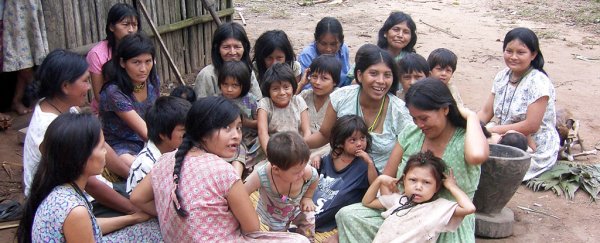A new study has found that the Tsimané people in Bolivia have less heart disease than any other population ever recorded. In fact, an 80-year-old Tsimané person has healthier arteries than a 55-year-old American.
The Tsimané are an indigenous society living in the tropical forests and savannas of north-eastern Bolivia. They are classified as forager-horticulturalists, which means they rely on both subsistence farming and foraging and hunting for their food.
For the past 15 years, coronary artery disease and stroke have remained the two biggest causes of death worldwide. Scientists look to pre-industrial populations such as the Tsimané for clues on how modern lifestyles are affecting public health.
While we can't all get back to fields and forests to maintain our health, we can definitely learn from what these indigenous cultures are getting right.
Researchers visited 85 Tsimané villages between 2014 and 2015 and took CT scans of nearly every Tsimané person older than 40 years. Measurements from 705 adults (aged 40-94) showed that a remarkable 85 percent of them had no risk of heart disease whatsoever.
Only 13 percent were at a low risk, and a mere 20 people out of 705 (or 3 percent) had moderate or high risk of heart disease.
"Most of the Tsimané are able to live their entire life without developing any coronary atherosclerosis. This has never been seen in any prior research," said one of the researchers, Gregory Thomas from Long Beach Memorial Medical Centre.
Atherosclerosis happens when cholesterol plaque and fats clog up the walls of the arteries, eventually causing blood flow problems and leading to heart attacks or strokes.
By contrast, a study of 6,814 participants in the US shows that more than 50% of all Americans have a moderate or high risk of heart disease, which makes it five times more common than amongst the Tsimané.
"By these findings, an 80-year old Tsimané possesses the 'vascular age' of an American individual in their mid-fifties," the scientists write in the paper.
So why are the Tsimané so spectacularly healthy?
The study was observational, so we can't draw a firm conclusion, but the researchers do point out that their diet and exercise levels are significantly different from what we see in sedentary industrialised societies such as the US.
First of all the Tsimané diet is nothing like what you would expect from the proponents of the 'paleo diet' shtick (all meat, no carbs.) In fact, it's exactly the opposite, which actually brings it in line with recent science on the topic.
As James Gallagher writes for the BBC:
17% of their diet is game including wild pig, tapir, and capybara (the world's largest rodent)
7% is freshwater fish including piranha and catfish
Most of the rest comes from family farms growing rice, maize, manioc root (like sweet potato), and plantains (similar to banana)
It is topped up with foraged fruit and nuts.
It means:
72% of calories come from carbohydrates compared with 52% in the US
14% from fat compared with 34% in the US, Tsimane also consume much less saturated fat
Both Americans and Tsimane have 14% of calories from protein, but Tsimane have more lean meat.
They also get excellent levels of exercise. Hunting, gathering, fishing, and farming keeps Tsimané men and women on their feet for the majority of the day, and they average between 4-7 hours of physical activity.
But we don't exactly know how much diet and exercise we need to slow down the clogging up of arteries that naturally happens with age - for all we know, running around for 6 hours a day could be overkill.
"Future studies addressing this issue might have strong implications on defining healthy behaviours for heart disease prevention," write the researchers.
These latest results are not entirely shocking, as previous research on the indigenous society has indicated their heart health to be excellent indeed. A 2012 study found that the Tsimané have better blood pressure when they get older.
"The Tsimané living conditions are similar to those of our ancestors, with greater exposure to pathogens, active lifestyle, high fertility and traditional diet. Studying chronic diseases in these populations can be very insightful," anthropologist Michael Gurven from University of California at Santa Barbara said in 2012.
Subsistence living is by no means a stroll in tropical paradise. The Tsimané lifestyle comes with its own risks, including more frequent infections. One of the intestinal worms that commonly affects Tsimané women could even be responsible for influencing their fertility.
Still, scientists think that insights from this study give us important clues on how to stay healthy in an increasingly sedentary world.
"[W]e believe that components of this way of life could benefit contemporary sedentary populations," says senior researcher Hillard Kaplan from the University of New Mexico.
"Their lifestyle suggests that a diet low in saturated fats and high in non-processed fibre-rich carbohydrates, along with wild game and fish, not smoking and being active throughout the day could help prevent hardening in the arteries of the heart."
The research has been published in The Lancet.
